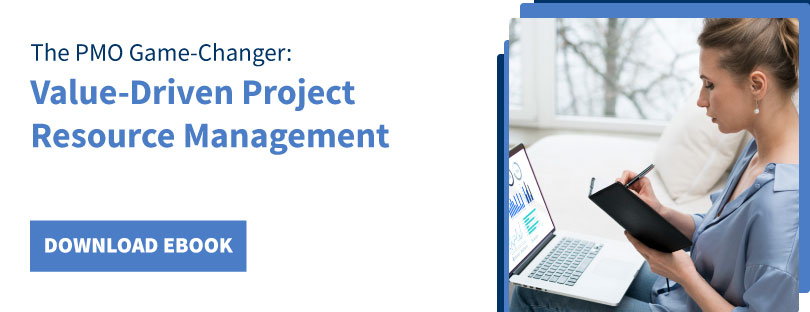‘The new normal’ became a buzzword after the onset of the unprecedented COVID-19 pandemic. The global outbreak caused a paradigm shift in the business landscape, organizational structures, and, most importantly, the market demands. All these shifts thereby introduced many ‘new normals.’
From the business skeleton standpoint, remote work, as we know, became one of the ways of life. Every industry, from IT to architecture, transitioned to teleworking. This led them to rethink their workflows and policy frameworks. Additionally, if the firms were project-centric, they had to revamp their whole portfolio and project management strategies.
Traditional PMOs based out of collocated offices became a thing of the past. The upheaval demanded virtual central governance.
However, a lot of the firms began questioning the relevance of PMOs – the nerve centers of project-based business.
These turbulent times compelled the CXOs of the firms to make some tough decisions, and this was one of them. But was it correct? Is it valid to dilapidate the central hub of coordination between project managers and stakeholders? Are PMOs really losing relevance in the post-covid world? This article answers all these questions here.

Before we delve into the granularity of the subject, let’s first understand the impact of the COVID-19 crisis on the project management landscape:
How did COVID-19 impact the Project Management landscape?
According to a survey conducted by PMI, 8 out of 10 respondents said that the COVID-19 crisis has had an extreme to a moderate negative impact on business in general.
This can be attributed to the worldwide mandated lockdown. Leaders were grappling with an array of challenges beginning from supply chain disruptions to changing consumer demands. Moreover, the economic downturn led to layoffs and salary cuts.
All these factors led to delays in project delivery. The PMI survey revealed that 29% of project deliveries were severely impacted due to COVID-19.
Constant communication is one of the significant pillars of successful project delivery. However, the enforced remote work culture made this a major challenge for a lot of firms. This is due to the fact a lot of businesses still followed traditional practices of working from collocated spaces.
With the entire workforce being dispersed across global geographical peripheries, it was highly arduous for managers and team members to get real-time updates of the project’s progress, leading to further delays and discrepancies in project completion.
The consumer demands saw a massive shift during the COVID-19 times, which made some projects obsolete. At the same time, the spiraling economy forced some clients to withdraw their projects, leading to heavy business loss to the firms. These scenarios made project managers reformulate their project selection criteria and let go of some of them from the pipeline.
The same PMI survey revealed that covid-19 impacted more than 60% of sponsors’ confidence in the project’s success negatively.
Not to forget, resource management was yet another process that faced the crippling effects of the pandemic. Keeping track of resource KPIs, maintaining their productivity levels, ensuring their engagement and mental well-being from different locations became tedious for managers.
All these challenges escalated the investment in technology and advanced tools to smoothen the transition from physical to virtual work environment. However, this was only possible with some well-defined standard rules and policies, and the PMOs were responsible for defining these for project-based organizations.
Let’s see how PMOs facilitated the firms to deal with these grim circumstances,
The role of PMO in dealing with unprecedented crisis
A modern-day PMO serves more than just being an administrative center. It can potentially become a value-driven profit center. It can regulate resource management strategies, maximize profitability, and meet the strategic objectives while also looking after the admin work.
Here is a run-down of PMO’s roles and responsibilities that helped organizations deal with the COVID-19 crisis,
The central hub to form standardized rules and contingency plan
The pandemic put forth an array of uncertainties and risks in terms of economic crisis, unplanned leaves, and more. The PMO of the organizations carefully assessed each risk and formulated a new contingency plan to navigate through the uncharted territory. Additionally, they negotiated with the stakeholders to either make the deadlines flexible or hold the request for a stipulated time.
As we know, a firm deals with multiple projects simultaneously, and it requires a standard framework to ensure efficiency and uniformity in processes. To ascertain that all project managers follow standard protocols, PMOs also acted as a bridge between them and developed a new set of policies for the remote project and team management.
Prioritizing projects in alignment with the current situation
As discussed earlier, the worldwide recessions and a colossal shift in consumer demand brought a plethora of projects to a grinding halt. These volatile demands also propelled firms to alter their long-term strategic goals. PMOs are majorly responsible for aligning the projects with the company’s goals and objectives. This is why they reprioritized their project pipeline in alignment with the current situation.
A classic example is a shift from physical retail stores to e-commerce platforms. The entire FMCG industry formed its web portal to stay afloat amid the lockdown. Moreover, luxury clothing brands shifted their focus to manufacturing essential safety gear to expedite their sales.
Implementing the technology infrastructure for a smooth transition
Remote work would have been impossible without the advanced technology and tools. However, not every tool or software can help your firm sail through the challenges smoothly. Thus, the decision-makers must assess and evaluate every tool or software you plan to invest in.
The onus lay on PMOs to understand the team and managers’ needs and accordingly select the tool repository. After all, these tools would be the enablers going forward. Thus, the PMOs implemented the right technology infrastructure to facilitate a hassle-free transition from physical to remote work.
Managing and regulating the organizational resource pool
The pandemic did not just affect businesses; it affected humankind as a whole. Employees were in constant stress due to an unimaginable increase in the number of cases, and the growing uncertainties added on to it. Thus, it was of prime importance to keep their mental and physical well-being in check while getting the work done.
The PMOs took charge and ascertained that every resource is at its productive best while giving enough room to cope with the crisis. At the same time, they constantly coordinated with resource and project managers to ensure that every resource is allocated to the right job and each one has enough work on their plate. This, in turn, led to the successful completion of projects within time and budget, even during times like these.
Training the project managers to combat the unforeseen events
No one saw this situation coming, and every contingency plan or risk management framework was just a trial and error. The situation demanded a leader who could stay strong and level-headed to steer his/her team to reach the other side unscathed. PMOs were these leaders for project managers. They were responsible for helping them tackle the unforeseen events head-on.
Some PMOs organized dedicated remote training sessions for project managers to give them a direction as to how to manage projects and resources. Financial regulation of these projects was the topmost priority given the crunch. Thus, along with serving this message, PMOs also conveyed the altered goals with regards to the evolving demands and formed guidelines for efficient workforce management.
These scenarios are evident enough to exhibit a PMO’s significance in project-led businesses. And were these challenges tackled from a physical workspace? Not at all. A traditional PMO transitioned to a virtual set-up altogether in need of the hour.
The need for a PMO- now more than ever
The NHS Nightingale Hospital in London, UK, took external help to set up central governance to cater to the surge in demand for hospital capacity. After integrating diverse organizations and forming solid coordination between their activities, the hospital witnessed miraculous results.
The PMO established a shared data environment for collaboration, information management, communication, and document control, which led to staffing the right personnel for the right tasks. They enabled different project leaders to collaborate and learn from each other by setting up three calls a week.
All these initiatives led to a smooth transition and well-regulated management of the hospital. This case study mentioned above shows the roles that PMO played in times of crisis and how the need for PMO has become more prominent during turbulent times.
In fact, according to a Gartner survey, 70% of organizations that implemented a PMO reported an improvement in project success rates.
Now that the importance of having a dedicated PMO is established let’s look at how the post-covid PMOs will look like,
Digital PMOs- The new normal in the remote work environment
Remote work is here to stay. Another recent Gartner CFO survey revealed that over two-thirds (74%) plan to permanently shift employees to remote work after the Covid-19 crisis ends.
This implies that physical PMOs are bygones, and the digital or virtual PMOs will take over in the post-covid world. These virtual PMOs will supervise every aspect, starting from project selection and controlling the project’s lifecycle to maximizing utilization of the workforce.
To catalyze these processes, the PMOs will be supported by a solid technological tools inventory. It would comprise major software like project portfolio management, resource management, collaboration tools, and more.
The question is, will this benefit in the long run?
The digital PMOs will run on unified platforms that will help the firms maintain a single version of the truth. This will enhance the transparency across the enterprise and stakeholders by many folds. As a result, decisions will become more data-driven, and the overall organizational efficiency will see a steep rise.
In a nutshell, like every cloud has a silver lining, so does this crisis, leading to a more transparent, open governance format.
Talking about software, a resource management solution can become a major game-changer for virtual PMOs. Here’s how,
How can a resource management solution be a game-changer in digital PMO?
Resources or the talent pool of the organization drive the projects to success. Thus, PMOs must always strive to keep their productivity and performance at their best. To do so, tapping into the right potential is extremely necessary.
However, how can a PMO manage a vast expanse of resource pools dispersed across boundaries?
This is where a resource management solution comes into the picture. It can provide a plethora of benefits to PMOs. Here’s the list:
- Unmatched enterprise-wide visibility
Using the solution, PMOs, project managers, and resource managers will get 360-degree real-time visibility of the resources, profiles, and schedules.
- Foresight into pipeline project demand
The resource management tool will foresee the project demand that will allow managers to form a resource plan ahead of the curve. Resource managers will have enough leeway to implement the right resourcing treatments to create an appropriate resource mix.
- Real-time insight into resource metrics
To assess the resource performance on a timely basis, the PMOs and the higher-ups will get real-time reports about resource utilization (billable, non-billable, and strategic), availability, planned vs. actual metrics, and so on. They can leverage these reports to take remedial actions in advance.
- A systematic resource requisition workflow
Resource requisition is a critical step in project management. Using the tool, project managers will be able to raise a request in time, and resource managers will fill them based on project criticality rather than a first-come, first-serve basis. Moreover, the tool maintains an audit trail for all concerned authorities that will minimize internal conflicts.
- Beat market volatility with accurate foresight
Resource management software provides substantial insights into future skillsets and project demand. A PMO and resource manager can gauge the existing skills gap and organize internal training to upskill the employees. This will allow PMOs to futureproof the workforce and accomplish more diverse projects with fewer resources.
Subject to these benefits, resource management software will become an incumbent part of a successful PMO.
In conclusion, is a final verdict of the impact of PMO during COVID and whether it will be relevant in the post-covid era.
Final Verdict- What does the future of PMO look like?
A PMO is the cornerstone of the successful execution of projects. It is the vital link between the project managers and resource managers, project managers and stakeholders, etc. For example, a PMO acted as the resilient bridge during the pandemic that facilitated the project managers and team members to switch to the remote work environment hassle-free.
So, the PMO’s relevance in the post-covid era is out of the question. However, as change is the only constant, the PMOs will see a massive transformation in terms of their structure and strategy. They will go digital, and the decision-makers will be running the office from across geographical peripheries. The strategy to select and manage the projects will be reinvented, and technological advancements will form an integral part of the PMO’s assets.
PMOs will, in fact, become all the more critical in the post-covid era to ensure the smooth functioning of the remote teams.
What do you think? Will PMOs become obsolete, or will digital PMOs take over?
Glossary
Saviom Solution
SAVIOM is the market leader in providing an Enterprise Project Resource Management solution. With over 20 years of experience leading the market, Saviom is actively used by over 15 highly-esteemed global companies worldwide. The tools within the suite include project portfolio management, professional service automation, and workforce planning software. It also entails supporting solutions to schedule equipment and assets seamlessly. Re-engineer your project management efficiency with a system shaped around your business!















